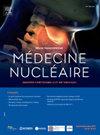[68Ga]-Ga-PSMA-11、[18F]F-FDG和[18F]- f胆碱PET/CT对mCRPC [177Lu]-PSMA放射配体治疗资格的影像学筛查
IF 0.2
4区 医学
Q4 PATHOLOGY
Medecine Nucleaire-Imagerie Fonctionnelle et Metabolique
Pub Date : 2025-03-01
DOI:10.1016/j.mednuc.2025.01.162
引用次数: 0
摘要
目的评价[18F]F-FDG (FDG)和[18F]-胆碱(Fcholine)在[68Ga]-Ga-PSMA-11 (PSMA) PET/CT对转移性去势抵抗性前列腺(mCRPC) [177Lu]-PSMA (LuPSMA)放射治疗的不一致病灶检测中的表现。方法本研究是一项多中心回顾性研究,纳入了在mCRPC患者进行LuPSMA (I&;T或617)放射配体治疗前进行FDG、FCholine和PSMA PET/CT检查的成年人。30天内进行PSMA和FDG PET/CT检查,45天内进行FDG和FCholine检查。在此期间,法国监管机构要求在进行PSMA PET/CT之前使用氟胆碱。在基于病变的水平上,采用两组不同成像阅读顺序的读卡器(第一组:PSMA、FDG和Fcholine)进行成像分析。/第二组:PSMA、Fcholine和FDG)。主要结局是PSMA-和FDG-PET (PSMA- fdg)以及PSMA-和Fcholine-PET (PSMA- fcholine)结果不一致的患者百分比。次要观察指标为FDG与Fcholine PET的一致性和不一致性。结果2021年5月至2022年6月共纳入60例患者,中位年龄74岁[IQR, 68-79岁]。57/60(95%)、35/60(57%)、20/60(33%)的患者在PSMA PET/CT上有骨骼、淋巴结和内脏疾病。16/60(26%)的患者发现PSMA-FDG不一致,5/16(31%)的患者发现脏器、8/16(50%)的患者发现淋巴结、9/16(56%)的患者发现骨不一致病变。60例患者中有18例(30%)发现psma -胆碱不一致。内脏病变无差异(0/18),而8/18(44%)、13/18(72%)患者在Fcholine上出现淋巴结和骨转移的不一致。在PSMA-FDG不一致的患者中,8/16(50%)的PSMA-Fcholine分析也不一致。PSMA-FDG分析未检测到的psma -胆碱不一致仅在8/18(44%)患者的骨骼和2/18(11%)患者的淋巴结中观察到。结论与FDG相比,Fcholine PET/CT不能检测到考虑进行LuPSMA放射治疗的mCRPC患者的不一致内脏病变。氟胆碱PET/CT检测的仅骨病变的预后意义有待进一步评估。本文章由计算机程序翻译,如有差异,请以英文原文为准。
Imaging screening with [68Ga]-Ga-PSMA-11, [18F]F-FDG, and [18F]-FCholine PET/CT for [177Lu]-PSMA radioligand therapy eligibility in mCRPC
Objective
To assess [18F]F-FDG (FDG) and [18F]-Fcholine (Fcholine) performance for discordant lesion detection with [68Ga]-Ga-PSMA-11 (PSMA) PET/CT for [177Lu]-PSMA (LuPSMA) radioligand therapy eligibility in metastatic castration-resistant prostate (mCRPC).
Method
This multicenter retrospective study included adults who performed FDG, FCholine and PSMA PET/CT before LuPSMA (I&T or 617) radioligand therapy in mCRPC. PSMA and FDG PET/CT were performed within 30 days and FDG and FCholine within 45 days. During this time, the French regulatory agency required the use of Fcholine prior to performing a PSMA PET/CT. Imaging analysis on a lesion-based level was performed by two groups of readers with different imaging reading order (Group 1: PSMA, FDG and Fcholine. / Group 2: PSMA, Fcholine and FDG). The primary outcome was the percentage rate of patients with discordant findings between PSMA- and FDG-PET (PSMA-FDG) and between PSMA- and Fcholine-PET (PSMA-Fcholine). The secondary outcome was the concordance and discordance rate between FDG and Fcholine PET.
Results
A total of 60 patients (median age, 74 years [IQR, 68–79 years]) were included between May 2021 and June 2022. 57/60 (95%), 35/60 (57%), 20/60 (33%) patients had bone, lymph node, and visceral disease on PSMA PET/CT. PSMA-FDG discordance was found in 16/60 (26%) patients and discordant lesions were detected in viscera, lymph nodes and bone in 5/16 (31%), 8/16 (50%), 9/16 (56%) patients, respectively. PSMA-Fcholine discordance was found in 18/60 (30%) patients. None of the patients had discrepant visceral lesions (0/18), while 8/18 (44%), 13/18 (72%) patients presented discordant findings for lymph nodes and bone metastases on Fcholine. Among patients with PSMA-FDG discordance, 8/16 (50%) also showed discordance in PSMA-Fcholine analysis. PSMA-Fcholine discordance not detected by PSMA-FDG analysis was observed only in bone in 8/18 (44%) patients and in lymph nodes in 2/18 (11%) patients.
Conclusion
Compared to FDG, Fcholine PET/CT did not detect discordant visceral lesions in patients with mCRPC being considered for LuPSMA radioligand therapy. Prognostic significance of bone-only lesions detected by Fcholine PET/CT requires further evaluation.
求助全文
通过发布文献求助,成功后即可免费获取论文全文。
去求助
来源期刊
CiteScore
0.30
自引率
0.00%
发文量
160
审稿时长
19.8 weeks
期刊介绍:
Le but de Médecine nucléaire - Imagerie fonctionnelle et métabolique est de fournir une plate-forme d''échange d''informations cliniques et scientifiques pour la communauté francophone de médecine nucléaire, et de constituer une expérience pédagogique de la rédaction médicale en conformité avec les normes internationales.

 求助内容:
求助内容: 应助结果提醒方式:
应助结果提醒方式:


